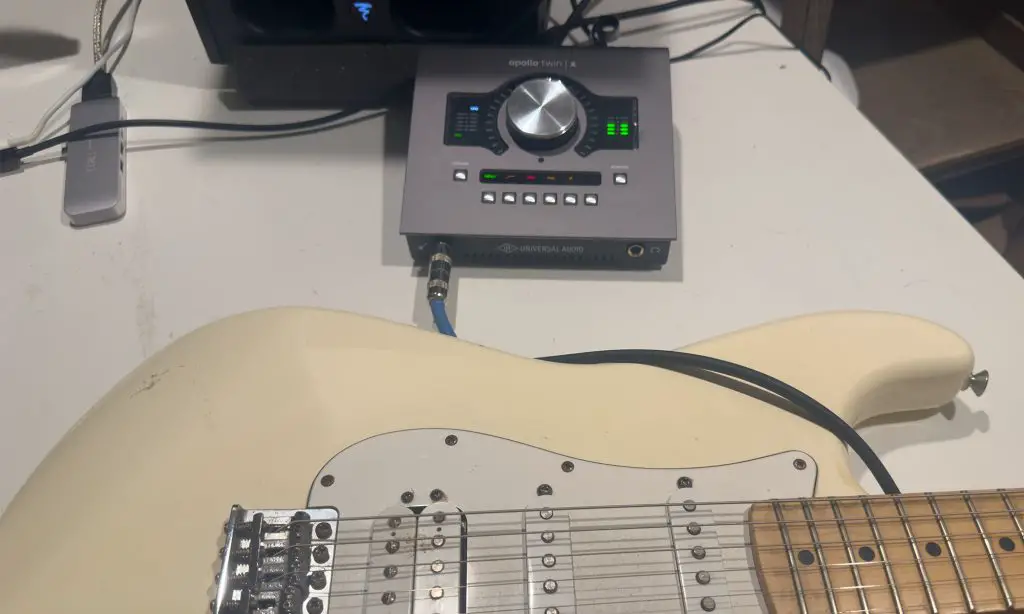Table of Contents
Universal Audio is a global leader in audio production equipment with a history of over 80 years. They’re responsible for some of the industry’s most iconic studio equipment, such as the 1176LN Limiting Amplifier, LA-2A Leveling Amplifier, an array of rack gear, and, more recently, their Apollo digital audio cards. These audio interfaces are at the forefront of home and professional studios, powering recording sessions around the globe.
Personally, I have used their audio interfaces for close to a decade, having tried everything from their Volt series to even powering my studio with an Apollo x8 Thunderbolt. For a bit, I also had an Apollo Twin connected to the x8 for even more control, as the two talk to each other seamlessly while adding 32 channels of ins/outs to my setup.
Regardless of which model, I have always been impressed with its clarity, ease of setup, and, most importantly, reliability. It’s why I keep returning to its products, even after trying many others. While I could write a novel about my experiences with UAD’s various audio interfaces and the value each has added to my process, we are focusing on their new Apollo Twin X Thunderbolt Interface today.
What Is The Universal Audio Apollo Twin X?
The Apollo Twin X is a high-performance audio interface designed by Universal Audio. That’s a big phrase for a audio interface that connects to your computer via a thunderbolt cable. It is part of their acclaimed Apollo series, and combines professional-grade audio conversion with real-time UAD processing. This makes it a powerful tool for music producers, audio engineers, and recording artists. It’s even a great addition to podcasting and streamer setups.
It’s a compact audio interface that offers incredible quality without taking up too much space on your desk. One thing I’ve always loved about this model compared to their larger interfaces is that it offers the same audio clarity without requiring rack mounts or special casing on a desk. It travels perfectly and fits in my studio bag when I’m on the go, without compromising performance. Their consistency in delivering great products gives me peace of mind that my productions will sound great no matter my environment.
UAD has improved on the original Apollo Twin hardware by completely redesigning its digital and analog conversions, which provides increased dynamic range and ultra-low THD. This is a really fancy way of saying you are getting some of the highest-quality audio into your DAW, no matter the use case. Below, we are going to dive into the pros of this compact yet powerful digital audio interface.
Universal Audio Apollo Twin X Review – The Pros
Superior Sound Quality
The Twin X converts audio at 24-bit/192 kHZ, offering users incredibly high sound quality with recordings and playback. This allows for the most realistic sonic picture of your music, leading to cleaner mixes and overall output. It also features two unison-enabled preamps, allowing for precise emulations and adding authentic warmth and character to recordings. I love this feature, as it adds another layer of depth and character to the music I am writing.
In addition, its onboard DSP allows for real-time processing with the addition of UAD plug-ins. This enables users to record and mix with next to zero latency. I can attest to this as well, as I’ve run multiple channels of recording at the same time and have never felt a lag in my processing power.
The Twin X is available in two models, Duo and Quad. Duo features two SHARC DSP chips, while the Quad features four, allowing for varying processing power levels.

A look at the back of the Apollo Twin X, showing its different I/O routing options
Easy to navigate Interface
One thing I love about this product is how easy the display is to navigate. Surrounding the main volume knob are two additional meters, showing monitor levels as well as recording inputs. Below, it has two buttons, the preamp and monitor. Depending on your mode, six additional buttons at the bottom give you control over a couple of key features of this audio interface.
Switching to Preamp mode gives you instant control over the two inputs, an EQ low-end roll-off, and phantom power for any required equipment. You also can channel link the two available channels for more stereo control of the recordings. All necessary tools I find myself using frequently to dial in a specific tone or level of instruments.

A picture of the different options you have on the Apollo Twin X when preamp is selected
The Apollo Twin X features a built-in monitor system that allows for talk-back functions in the studio, alternate speaker outputs, and a few other great add-ons. Earlier in the article, I touched on having a Twin X linked to an Apollo X8 via a Thunderbolt cable. This was one of my favorite aspects of using UAD products. Controlling the talk-back mic and recording levels and seamlessly switching between the two made for some of my best recording sessions with clients.
I was able to leverage the larger sound card channel inputs while controlling it all from a more simple interface that sat conveniently in front of me on my desk. There is also a ‘dim’ button which comes in handy when you need to quiet your master signal without touching the master volume knob.

A picture of the different options you have on the Apollo Twin X when monitor is selected
Lastly, another favorite feature is the mono button you can toggle on. I love this because I previously had to load a plugin onto my master chain to check my mixes in mono. With this audio interface, I click one button and clearly understand what my song is doing. This aids me in hearing a realistic representation of how my instrumentation is leveling up against each other.
Perfect Portability
The Twin X offers a professional-grade interface that is also road-friendly. It offers a compact design that is light weight. With dimensions of roughly 6 inches by 6 inches and a height of 2.5 inches, it fits great in any studio road bag without weighing you down. I’ve brought it with me to use in hotel rooms or even at a local coffee shop when I just want to get out of the studio and do some headphone mixing for a few hours. It fits right in my go bag without needing to make more space for it.
It’s also rugged, offering a sturdy metal chassis that withstands the rigors of on-the-go studio sessions or performances. The sudden rise of DJ sets from exclusive locations also makes for a great production card to capture the recording of your next scenic set. I used an older Apollo X model when making a video from atop the Leveque Tower in Columbus, Ohio. It was a perfect addition, reliably capturing the audio I needed for post-production.

The Apollo Twin X takes up a small amount of space on any desk, highlighting its portability
Compatible with all major DAWS
The Apollo Twin X works seamlessly with all primary digital audio workstations, such as Pro-Tools, Ableton, Logic. In addition to major daw compatibility, it comes with its LUNA Recording System.
When using LUNA, you gain access to some of UAD’s prized plug-ins, such as Oxide Tape Extension and Shape, a multi-instrument plugin. Other extensions are available for purchase via the LUNA Pro Bundle. It’s a powerhouse addition to the Twin X that combines all its tool offerings in one program.
Access to UAD-powered plug-ins
As with any UAD interface, you will gain access to a massive bundle of plug-ins that emulate some of the most famous studio equipment. From the legacy versions of the LA-2A Classic Audio Leveler to the 1176LN Limiting Amplifier to the Pultec EQP-1A, and many more.
You also have the option to purchase more plugins that work hand in hand with the interface from UADs site. They constantly have deals for their reverbs, delays, and many other VSTs that will add an extra layer of creativity and control with the professional standard they are known for.
My personal favorite plug-in has been the Antares auto-tune plug-in, which I used for all the vocals on my album ‘Melodies In Harmony.’ Combining their interface with the plugin allowed me to leverage the power of this audio interface without my processing power taking a hit. It also retained a high level of audio quality throughout the production process aiding in my mixing/mastering process. The songs on that album are some of my favorite productions and I credit a lot of this to the tools UAD has released in unison with their sound cards.
…And The Cons
While the Apollo Twin X offers an array of plugins when you buy their audio interface, many will still have to be purchased. In addition to this, UAD installs all of its plugins with its sound card drivers, whether you have the full version or not. This can be a bit daunting when looking at the massive list, and trying to navigate which ones you have full control of. That being said, all the plugins allow you to run a 14-day demo trial, ensuring you like the features before pulling the trigger to add it to your collection.
While Apollo’s interface offers world-class sound, it doesn’t guarantee world-class results.
I find this important to mention because we often assume great music results just because we’ve acquired great products. The power still lies in the user’s ability to learn and understand this product to work it to its full potential. Being proficient in your production knowledge is essential to leveraging the power that comes with it.
Lastly, while it is a Thunderbolt 3 card, UAD does not provide the Thunderbolt cable with purchase. This isn’t the end of the world, but it is always nice to have everything needed in the box. I feel like adding this cable is a simple way to really improve users’ out-of-the-box experience while also making sure you have the proper cable to get the audio interface up and running.
Who Is The Apollo Twin X For?
As the title of this article suggests, this is a great product for any modern producer looking to add a powerful production card to their studio lineup. I will say, though, that I don’t think it’s an entry-level card.
That’s not a negative, though, as UAD still has a great entry-level line with their Volt series with affordable pricing. The Apollo X offers industry-standard quality while still being just as portable and compact as the Volts series.
I think this card is for the serious producer looking for something compact that offers the same audio output you’ll find in any major recording studio.

The front of the Apollo X features two 1/4″ jacks. One thats a direct in for instruments, and the other for headphone monitoring
Final Thoughts
The Apollo Twin X comes with a much-deserved reputation.
No matter your level of proficiency, UAD offers a user-friendly and easy-to-set-up product. While it has many layers to its use cases and abilities, it still offers an easy-to-navigate interface. In addition, they have a great support forum and network, where almost any question you may have can be answered. I’ve often found myself on them, immersed in a community ready to share their thoughts, tips, and tricks about UAD products.
These audio interfaces power professional, home, and bedroom studios.
No matter their setting, they offer the same consistent sound UAD is revered for. They consistently set a standard in the audio world, leaving the bar for Digital Audio Interfaces incredibly high. From its internal processing to the plugin library accompanying it, it makes a great addition to any studio setup. They’ve become a staple in my studio, and I look forward to how they continue to develop their products for years to come.
The post Universal Audio Apollo Twin X Review: One Of The Best Audio Interfaces For Serious Producers appeared first on Magnetic Magazine.



